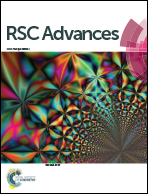Superhydrophobic nanocomposites from biodegradable thermoplastic starch composites (Mater-Bi®), hydrophobic nano-silica and lycopodium spores†
Abstract
Due to increasing environmental concerns related to bio-persistence of petroleum based polymers, research efforts have intensified towards developing biodegradable materials with equivalent performance properties. Among these properties liquid repellence is one of the most challenging to obtain due to the fact that most biopolymers such as polysaccharides or bio-polyesters are hygroscopic or hydrophilic. One possible approach is to formulate biopolymer nanocomposites with water repellent properties. Here, we demonstrate such an approach using a commercial thermoplastic starch composite, Materi-Bi®, hydrophobic fumed silica nanoparticles and lycopodium spores. We found that both hydrophobic fumed silica and Materi-Bi® have excellent colloidal stability and solubility in chloroform and they can be spray coated onto various surfaces like paper, metals and semiconductors. By varying the concentration ratio of biopolymer to hydrophobic fumed silica, the wetting properties of the nanocomposites could be tuned. Superhydrophobic nanocomposites displayed raspberry-like surface roughness with water contact angles exceeding 160° with very low water droplet roll-off angles (∼1°). On the other hand, composites of Materi-Bi® and lycopodium spores displayed sticky superhydrophobicity (rose petal effect). Superhydrophobic nanocomposites were found to withstand thermal aging at 250 °C without loss of properties. Due to the resultant micro-morphology of the nanocomposites, certain coatings were rendered superoleophobic by functionalizing with a dilute fluoroacrylic polymer solution in acetone. Oil droplet contact angles reached 166° with droplet roll-off angles of approximately 15°.


 Please wait while we load your content...
Please wait while we load your content...